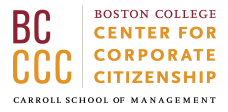WEBINAR: This webinar explores how to measure and communicate your organization's social impact with proven frameworks and strategies that matter to stakeholders.
Mentoring in the Workplace: Program Examples & Best Practices

According to a CNBC survey on workplace happiness, more than 9 in 10 workers (91%) who have a mentor at work report feeling satisfied with their jobs, including a majority (57%) who feel “very satisfied.” This same group is also more likely to feel satisfied with their compensation and appreciated by colleagues as compared to those without a workplace coach. Meanwhile, a 2022 survey of working adults conducted by the Gallup Center on Black Voices found that mentors and sponsors are “crucial to shaping the employee experience.” Mentors themselves benefit from structured mentoring; they’re more likely to be retained and to mentor others both in formal workplace programs and outside of them in the future.
Powerful stuff, right? But, not every employee lucks into a mentoring relationship. Most mentoring still happens informally, leaving out a lot of workers—especially workers from underrepresented groups. Gallup data indicates only about 40 percent of employees report having a mentor at work. The other 60 percent may be missing out on a lifetime of enhanced job satisfaction or career advancement opportunities as a result.
So, how can companies be more intentional about mentorship opportunities—implementing structured programs that support team members equally? How do smart corporations go about pairing associates together—one-on-one, in groups, or perhaps even with local students—for the most effective learning and career growth experiences? What are the different mentoring models companies might follow? And what are the benefits derived from an investment in mentoring? We spoke to corporate citizenship leaders at BCCCC member companies SOLV Energy, Vertex Pharmaceuticals, and AAA – The Auto Club Group (ACG) for answers to these questions and more.
Skip ahead to read about the SOLV Energy mentoring example, the Vertex Pharmaceuticals mentoring program, or ACG’s youth mentoring efforts.

What are the different models of mentoring in the workplace?
Workplace mentoring programs can happen in many forms and address a variety of goals. We’re all familiar with the concept of traditional, one-on-one mentoring. Typically, the one-on-one mentor is someone who is not in a mentee’s direct line of supervision, and who can offer helpful guidance about where one might need development and how to get it. This type of mentor might advise a mentee on big-picture issues like career path, while also helping to negotiate more day-to-day issues like office politics, processes, and relationships with peers and superiors.
But professional learning, development, and networking can also happen in groups, through mentoring circles. Group or circle mentoring usually involves a facilitator, one or more mentors, and multiple mentees. Group mentees typically have something in common, whether it’s tenure, shared skills, goals, or experiences. Group mentoring is often found in new employee onboarding programs or sometimes happens within employee resource groups (ERGs) or business resource groups like those at T. Rowe Price. Mentoring is also a common practice among companies with supplier diversity programs.
Vertex Pharmaceuticals is a good example of how companies can utilize different types of workplace mentoring to address different audiences and different goals. The company offers a Global Mentoring Program for all permanent employees in its offices around the world. Vertex’s employee resource networks (ERNs) also host mentoring programs including reverse mentoring and peer-mentoring circles. These programs are also open to all permanent employees globally.

How common are formal workplace mentoring programs? Why are they becoming more popular?
According to a study conducted by the Association for Training and Development, 71% of Fortune 500 companies employ mentoring programs to develop talent internally. While mid-size and smaller companies may be slower to implement formal mentoring programs, there is evidence to support the business case for getting started—especially for younger generations of employees. Deloitte recently found that Millennial and Gen Z employees value learning and development opportunities second among all draws to a given workplace—above “high salary” and other financial benefits, in fact. What’s more, this same survey found that nearly half of Gen Z’s (47%) and a majority of Millennials (54%) who didn’t “feel heard” at their organizations intended to leave current roles within a year. For these groups, reverse mentoring may supply critical opportunities for colleagues to listen to and value incoming voices. Finally, the Covid-19 pandemic, followed by a mass adoption of remote work, has exacerbated a broader, age-agnostic set of people challenges—disconnect, disengagement, widening gender disparity—for human resource teams. For some companies, virtual mentoring is now helping to address these concerns.
What's the difference between workplace mentoring and sponsorship?
Mentors offer feedback and coaching. Sponsors use their professional sway and influence to actively advocate on a colleague’s behalf. According to Gallup workplace data on mentoring, “anyone who has support and advice to share can provide effective mentorship, regardless of their role or tenure. On the other hand, workplace sponsors are in a position of power and actively promote growth, provide access to opportunities at work, and advocate for the career advancement of a less-experienced individual.”
Clearly, sponsorship is a much bigger “ask” of anyone participating in a formal company initiative. So, although there are some companies who have formal sponsorship programs in place, the process is trickier and necessarily narrower in scope. Some say employees who are looking for a sponsorship relationship often do better developing these connections organically. And, in fact, many workplace sponsors started out as mentors who opted to take a next step in the professional relationship.

Which employees make good mentors?
It’s important to note that workplace mentors can come from any level and branch of the org chart. Some mentors are senior leaders shepherding more junior leaders or managers in an executive mentoring program. Some mentors are actually new hires or younger associates who practice reverse mentoring or reciprocal mentoring in order to educate more tenured employees on contemporary tools like social media or AI. Reverse and reciprocal mentoring can also go beyond workplace tools and skills to address broader gaps that may exist, in terms of communication and culture, between employees of different generations or backgrounds. Some companies may use employees to mentor local students, connect employees with one another as part of diversity networks, or even help their diverse suppliers improve and grow as small businesses.
Bottom line: any employee with a willingness to share time and support has the potential to act as an effective mentor to someone, but mentor matching remains a key step in the process…

How do companies match mentees with suitable, effective mentors?
Getting this piece right can be the trickiest, most time-consuming aspect of a mentoring program launch. As SOLV Energy grew its efforts from a pilot program with just 40 employees (20 pairs) involved to over 200 (100 pairs), they turned to a mentoring software solution for help with mentor matching.
“Without this move to technology, our program would not have been manageable at [the current] size,” shared Sadaf Amini, Talent Development Manager at SOLV Energy. “One of the key aspects of MentorcliQ’s mentoring software is the automated SMART matching capability… Not having to manually match our growing participant pool saves us time and money. As an innovative technology company ourselves, we fully embrace leveraging technology to be more effective and efficient in our talent management efforts.”
At Vertex Pharmaceuticals, the company’s Global Mentoring Program also utilizes MentorcliQ. “Some of our ERNs use this platform for their mentoring programs, as well,” added Millie Brook-Smith, Talent Management Senior Manager. “This platform uses an algorithm with pre-set questions for mentees: areas of interest, professional/technical skills they wish to develop, time zone preferences, and a text box for any specifics. Similar questions are asked of the mentor, who must select the areas/business functions they are experienced in. All participants complete a picture personality survey. The algorithm uses this information to process matches, then a member of the Vertex Talent Management team will manually review suggestions and complete matches. Resources and communications are housed in the system.”
Besides MentorcliQ, other employee mentoring platforms include Qooper, Together Mentoring, and Ten Thousand Coffees. In addition to supporting the mentor-mentee match process, these tools can help CSR leaders track employee mentoring progress across their programs and gather participant feedback.

BEST PRACTICES | ADVICE FOR COMPANIES LOOKING TO LAUNCH A WORKPLACE MENTORING PROGRAM
While the benefits of formal workplace mentoring programs are clear, the roadmap to success isn’t always as such. To help other companies get mentoring programs off the ground, Sadaf Amini, Talent Development Manager at SOLV Energy, offers the following advice:
Clearly Define Goals and Objectives:
Begin by identifying the specific goals and objectives of your mentorship program. Clearly articulate what you hope to achieve, whether it's fostering employee development, increasing retention rates, or enhancing leadership skills.
Align with Organizational Culture:
Ensure that the mentorship program aligns with the overall culture and values of your organization. This alignment contributes to the success and sustainability of the program.
Create a Structured Program Framework:
Develop a structured framework for the mentorship program that includes guidelines, expectations, and a clear timeline. This structure helps participants understand their roles and responsibilities.
Recruitment and Matching:
Carefully select mentors based on their expertise, experience, and willingness to commit. Likewise, consider the goals and aspirations of mentees when making pairings to ensure compatibility.
Provide Training for Participants:
Offer training sessions for both mentors and mentees to ensure they understand their roles, the purpose of the program, and effective communication strategies. Training can enhance the overall effectiveness of the mentorship relationships.
Encourage Open Communication:
Foster an environment that encourages open communication between mentors and mentees. This includes regular check-ins, feedback sessions, and a willingness to address any challenges that may arise during the mentorship.
Measure and Track Progress:
Implement a system to measure and track the progress of the mentorship program. This could include key performance indicators (KPIs) related to professional development, employee satisfaction, and other relevant metrics.
Promote Diversity and Inclusion:
Strive for diversity in your mentorship program to ensure a broad range of perspectives. Consider factors such as gender, ethnicity, and background to create a rich and inclusive learning environment.
Recognize and Celebrate Success:
Acknowledge and celebrate the achievements of both mentors and mentees. Recognition can include public acknowledgments, awards, or other forms of appreciation to motivate and inspire participants.
Continuous Improvement:
Regularly evaluate the mentorship program and be open to feedback from participants. Use this information to make continuous improvements and adjustments to ensure the program remains effective and relevant over time.

What are the benefits of workplace mentoring programs?
When SOLV Energy set out to formalize its talent development efforts, some of its primary goals were as follows: to build positive relationships; to facilitate continuous learning; to cultivate a welcoming, supportive workplace culture; to engage and inspire employees, who in turn would share their excitement with customers; and to accelerate skills development that would support the future of the company. More specific to the different parties involved, here’s a look at some additional benefits SOLV Energy targeted:
Benefits to the Mentee
SOLV Energy reports that its workplace mentoring program has helped mentees gain and grow in all the following ways:
- Accelerate career development
- Build connective tissue across the organization
- Explore potential in development areas yet untapped
- Expand leadership abilities
- Increase technical skills
- Learn about another department in the company
- Acquaint yourself with the company if you are a new employee
- Make valuable contacts within the company
- Expand your personal network
- Find allies and advocates within the company
- Meet subject matter experts
“Through the Mentorship Program, I was able to receive guidance and build confidence in my ability to grow in my career and challenge myself,” shared Alyssa Grant, Community Engagement Manager at SOLV Energy and a mentee in the company program. “It was such an amazing experience to connect with someone outside of my typical day-to-day team who had such a wealth of knowledge to share.”
Benefits to the Mentor
Vertex’s Brook-Smith says the benefits to mentors themselves are equally valuable. “Our survey results show mentors learn from their mentees… Communication differences at the different business levels and among different cultures, [new perspectives on] navigating the business at lower levels, what motivates those in other areas of the business, and a chance to reflect on the mentor’s own experiences.”
SOLV Energy leaders agree, pointing out that some of its mentors reported getting more out of the program than their mentees. Additional benefits cited on the mentor side included: the opportunity to build leadership skills; promote more inclusive practices; increase awareness of personal biases, assumptions, and areas for improvement; not to mention the personal fulfillment gained from investing in others and the future of the company.
How mentoring programs benefit companies
When well executed, mentoring programs deliver manifold benefits to the companies that invest in them: the talent pipeline grows, employees become more engaged, and turnover decreases. A study of 3,813 working professionals in the United States found that a high-quality mentoring relationship can actually protect an employee’s firm commitment and health from the negative effects of a poor diversity climate.
Want more examples of companies with mentoring programs in your industry?
Curious what a mentoring program framework might look like? Just ask us. We're happy to provide a free report via our Knowledge Request service for BCCCC members.
Measuring the impact of workplace mentoring
As part of the Global Mentoring Program, Vertex participants receive a survey upon completion of the six-month engagement. “We measure the success of each relationship from both the mentor and mentee perspective through a 1 to 5 star rating of match quality and resources,” offered Brook-Smith. “We have consistently maintained a rating of above 4/5 stars for the program since its initiation. Additionally, our ERNs send out surveys for the programs they host to track experiences and ways to improve their programs with each cohort.”
Similarly, at its most recent three-month lookback, SOLV Energy is seeing impressive results. Ninety-six percent of employees who raised their hand to participate have been matched with a mentor or mentee. Over 460 hours of mentoring have been reported, with mentors tackling topics like individual development, career development, organizational knowledge, collaboration, and more. Most importantly, mentees surveyed report a 4.7-star (out of 5) satisfaction rate with their mentors.
But what about measuring broader impact? How can companies translate results into concrete terms when mentoring programs aim to help diversify the talent pool, enrich communities, or accomplish other goals outside the organization? BCCCC has a course for that…
Do you need help measuring the impact of your corporate social responsibility programs?
What about determining ideal goals, outcomes, and metrics in the first place? BCCCC has an online, self-paced course for that. Learn more about Corporate Citizenship Impact Measurement & Evaluation.

Examples of companies with student or youth mentoring programs
For some companies, mentoring means helping students take the leap from high school into college and/or the workforce. High school and college students don’t always leave their (post) secondary schools with the skills needed to find and gain satisfying employment—if they make it to graduation at all. School counselors—especially those in under-served communities—are often stretched too thin to play an effectual role for all the young people who need them. So even for students who know they want to pursue higher education, it can be challenging to find the support required to navigate career prospects, college applications, or relevant work experience. Many companies now work to address these gaps in career resources and readiness by offering employee volunteers as student mentors. EY, for example, has helped more than 2,500 students over the course of several years with its College MAP (Mentoring for Access and Persistence) program, a model of private sector mentoring to support access to education for underserved youth and develop future generations of talent.
Employee mentors provided concentrated, one-on-one attention, tailored to their mentees’ career goals and interests—ideally, using their own professional experiences in a similar field. Mentors can help students explore post-secondary options, prepare for standardized exams, revise application essays, hunt for scholarships, and more. For those heading straight into the workforce, mentors may be instrumental in developing time management skills, problem-solving skills, even a healthy sense of work-life balance.
Supporting youth through employee volunteerism (youth mentoring) is another common corporate mentoring approach, which fosters connections between skilled employees and students on a variety of topical or general areas. Employees might partner with an at-risk youth to simply provide a positive role model, or they might advise them in a more specific way on pursuing studies in science, technology, engineering, and math (STEM) fields, for example. Some companies in the banking industry offer youth mentoring that covers financial literacy. Some media companies lend their creative teams to mentor youth interested in creating art or entertainment. Regardless of the focus area, youth mentors help to model the importance of networking, seeking opportunities, and building positive relationships with others.
Another example of student mentoring in action comes from AAA – The Auto Club Group (ACG), where promoting initiatives that help ensure equitable access to education is one of the company’s strategic priorities. Last year, ACG employees helped Detroit high school students who participated in a dual enrollment program at Wayne State University’s Mike Ilitch School of Business. “Aligned with our longstanding commitment to equitable education outcomes, the dual enrollment program is an excellent opportunity for ACG to contribute support toward improving the educational trajectories of low-income students and students of color,” explained ACG’s Cherisse Montgomery, Corporate Social Responsibility Program Manager. “Dual enrollment promotes intellectual growth and develops in-demand industry skills while providing college credit. It is a powerful jumpstart to the higher education journey for participating students.”
In 2023, students from three Detroit high schools participated in Business Administration 1000 (BA 1000), one of the fall courses offered to the dual enrollment students. The most highly anticipated project in BA 1000 is a “Shark Tank” pitch competition for student teams to conceive, research, develop, and pitch their innovations to a panel of judges. Across five weeks, ACG volunteers visited campus to participate as mentors to help coach and inspire student teams as they refined their pitches. The company’s CSR team selected volunteers who would best align with the program based on professional background and affinity. “We prioritized employees who had an affinity with the school as either alumni or other previous engagement with the university; we also prioritized those who had experience with youth development or education programs,” Montgomery reported.
The culminating events took place this past November. Several Auto Club Group leaders from product development, finance, sales, and DEI departments participated as judges to help crown the winners. "I mentored in both classes, so it was fascinating to see firsthand how these young thought leaders worked as a team to research a specific problem, develop a tailor-made solution, and then craft a story to help others see their vision," shared Montgomery. "These are skills that will translate easily into other domains of their lives."
How to promote mentoring programs to employees
Given all the benefits to everyone involved, it seems like promoting a mentoring program shouldn’t be such a heavy lift. And yet, many employees—particularly, the ones who need the engagement most—won’t seek out mentoring on their own. In order to draw in the biggest crowd, CSR and HR teams should plan to communicate what’s available as well as the many upsides of leveraging mentorship offerings. Short video testimonials from company executives who have reaped the rewards of mentoring are often effective tools. At Vertex, the Global Mentoring Program is advertised through global communications on the company intranet, regional lunch and learns, and HR communications related to career growth and development.
According to a mentoring study reviewed by BCCCC, the best mentoring communication starts with knowing your audience. Across the board, younger mentors are more likely to engage in a mentoring opportunity to help achieve career-related objectives, such as recognition, promotion, and monetary rewards, rather than more intrinsic motivators such as a desire to help others. Meanwhile, other volunteers will have little interest in climbing a corporate ladder; they might instead be drawn to the personal rewards and opportunities to forge connection. Program promotion should “speak to” these different audiences where they live.
Making it easy to participate is another way to engage more employees. Here again, employee mentoring technology may be helpful in structuring the process. Virtual platforms allow participants to create their profiles, share goals/areas of expertise, find matches, book meetups, track progress according to a provided framework, and more.
Want to learn more about workplace mentoring, but your company is NOT a BCCCC member?
You are still eligible to enroll in an online course like Advancing Inclusion and Diversity through Strategic Corporate Citizenship. This course can help you diagnose the current state of inclusion and diversity at your company, create an I&D plan, set up SMART goals, and other activities that may surround an employee mentoring program launch. Meanwhile, we would encourage you to ask us about BCCCC membership and its many benefits. Not sure BCCCC is right for your company? Browse this list of our current members.
Related Content
RESEARCH BRIEF - Researchers investigated how ESG activities help or hurt financial performance, using nine years of data from over 1,200 global companies.
RESEARCH BRIEF - Researchers analyzed 4 US energy exchange-traded funds (ETFs) over 15 years, including 2 dirty energy funds tracking fossil fuel companies and 2 clean energy funds tracking renewable energy companies.
RESEARCH BRIEF - Researchers conducted a survey, which measured perceptions of CSR and ethical leadership within the manufacturing and service industries.






